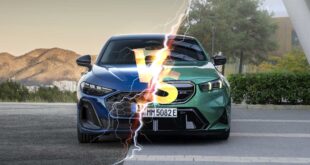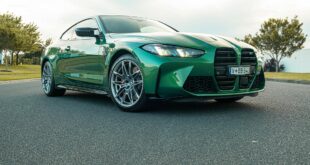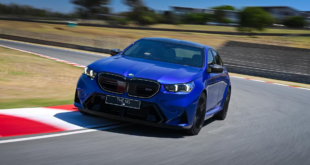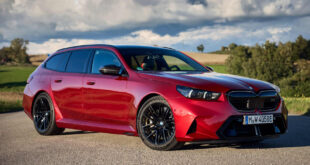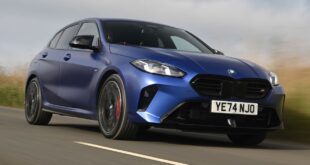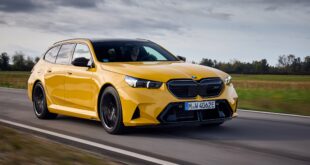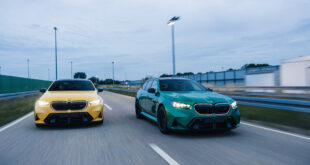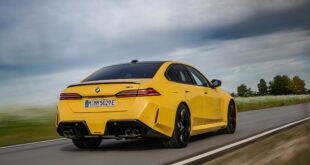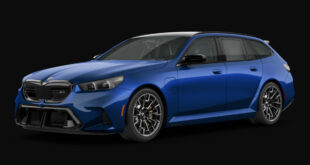The BMW M135i is the first petrol engine model to be presented in the new category BMW M Performance Automobiles. What are the car’s technical highlights?
Christof Lischka: The BMW M135i is the first petrol engine model of the BMW M Performance Automobiles as well as being the first representative of the 1 Series family. For this reason, it was important for us to give the BMW M135i the specific characteristics typical of all BMW M Performance Automobiles – specially matched to the 1 Series of course.
The target character of the BMW M Performance Automobiles is defined by agility, precision and emotion. This in itself is a perfect match for the BMW 1 Series. But it was also important to us to maintain full suitability for everyday use. This is what did in the BMW M135i: we revised the suspension, with modifications to the front axle, for example, by changing the transverse control arm and the swivel bearing. And we developed a new tyre which is used exclusively for the BMW M135i. The suspension settings were modified specifically in connection with these changes. In addition, the standard equipment was given a sporty upgrade. The car is fitted as standard with sports steering and sports chassis with its own suspension settings, sports brake and sports package. This allows us to differentiate it from the sportiest AG model, the BMW 125i, while still retaining sufficient comfort and suitability for everyday use.
You mentioned that the 1 Series already embodies the properties of the BMW M Performance Automobiles. Where are the differences as compared to the existing BMW M550d, BMW X5 M50d and BMW X6 M50d, for example?
The BMW 1 Series is already our showcase model in terms of directness and agile driving response. This is why it is especially difficult – but especially important for the M135i – to go one step further and differentiate it from a “normal†BMW 1 Series, though without losing the everyday suitability familiar from the basic models. For this reason we have exercised particular fine tuning in technical differentiation of the BMW M135i. The result is even more agile handling, a higher level of transverse force and superb precision, though without losing out on comfort and stability.
The BMW M135i features the BMW TwinPower Turbo engine of the N55 series with just one turbocharger. Why was this engine selected and not the N54, for example, which has two turbochargers?
The N55 has the potential for increased performance – in the BMW M135i we are offering 10 kW more than in the standard engine of the BMW 3 Series, as well as 50 Nm more torque. This gives us more than enough in terms of performance. With the sports automatic transmission, acceleration from 0 to 100 km/h takes 4.9 seconds – a top-class figure. So the N55 was an excellent match, there was no need to use the N54. Especially seeing as the N55 sets standards in the segment in terms of fuel consumption and CO2 emissions. With the sports automatic transmission we achieve a CO2 level of 175g / km and a combined fuel consumption level of 7.5l / 100km. This makes us the leaders of the vehicle segment in terms of fuel consumption and CO2 emissions.
Is the 450 Nm of torque available all the time or in an overboost mode?
The 450 Nm is permanently available.
Where are we with the BMW M135i in terms of weight?
The unladen weight is 1515 kg, so 1440 kg according to DIN.
Let’s take a closer look at the special components of the BMW M135i. We have a special brake system…
The 17″ sports brake is installed in the car as standard. It is a fixed caliper brake with four pistons at the front and two at the rear, and brake discs with larger diameters. This and the special tyres I mentioned give the car an impressive brake performance. The brake has a blue paint finish and bears the M logo.
Is the brake exclusively available for the BMW M135i or for all BMW 1 Series models?
The sports brake is available as an option for all BMW 1 Series models.
Are there any other features which are specifically for the BMW M135i, apart from those we’ve discussed?
We have 18″ mixed tyres in size 225 at the front and size 245 at the rear on an exclusive rim which is only available for the BMW M135i. On the exterior we have the typical components of the BMW M Performance Automobiles: ferric grey mirror caps and ferric grey blades in the air inlet. The air inlets have been enlarged for the powerful engine of the BMW M135i, and there are no fog lamps. As I mentioned, the M sports package comes as standard. The door sill strip shows the BMW M135i inscription, while the steering wheel and gearshift lever knob bear the M emblem. And when you get in and out of the car, the BMW M Performance inscription appears in the instrument panel. There is also the double rimmed exhaust system, exclusively available for the BMW M135i within the 1 series family.
The suspension settings were completely reworked to match the special tyres and the modifications to the chassis. The application of the steering, the adaptive M running gear and the entire powertrain was completely revised and newly harmonised. The exclusively developed tyre is provided solely as part of a mixed tyre combination. So we didn’t have to allow for a whole range of tyres of different dimensions, as is the case with the basic models.
So if I were to order a BMW 125i with adaptive M running gear or sports steering, for example, there would be a difference from the set-up of these components as compared to the BMW M135i?
Correct. It is not possible to give a BMW 125i the same characteristics and performance of the BMW M135i by adding special equipment options. Not only the transverse and longitudinal dynamics are different – the entire character of the BMW M135i is distinct.
In the predecessor generation of the new BMW 1 Series there was a BMW 135i, well a BMW M135i. If you had been limited to a BMW 135i now – would this car have been different?
Definitely. Looking at the features mentioned which are required to create the character of a BMW M Performance Automobile, we would not have implemented these in a BMW 135i. Apart from the lower engine power, the precision, agility, emotion and driving fun would not have reached the level now provided by the BMW M135i. The BMW 135i would have had more power but not a significantly different character from the other models of the series with lesser engines. And the additional weight of the high-performance 6-cylinder engine would not have been compensated for to the same extent as in the BMW M135i. It was the measures described which were able to supplement the longitudinal dynamics to create the spectacular agility, precision and lateral dynamics of the M135i. The engine acoustics have a great presence, too. The exhaust system was specially adapted. It was possible to leave out the centre silencer, while the exhaust flap control and engine application were adapted especially for the new M135i. The position of the driving dynamics switch is also incorporated here. We used all the conventional elements to create a thrilling sound.
Does the position of the driving experience switch have any other effect?
When you change from Comfort to Sport, the characteristic curve of the accelerator pedal and steering wheel are also altered, as is the setting of the optionally available adaptive M running gear. But the engine sound is also varied via the exhaust flap control and the engine application. The sound has a major impact on how the vehicle is perceived, and here again we offer pure emotion in the BMW M135i.
Are the 3-door and 5-door models of the BMW M135i different in character?
No. That was our aim – we didn’t want the two BMW M135i to be different in terms of driving dynamics.
How exactly did the engineers of BMW M and BMW AG collaborate on developing the BMW M135i?
It was important that the M characteristics typical of the BMW M Performance Automobiles were added by our BMW M GmbH colleagues. So we set up a kind of buddy system involving close collaboration between BMW M and BMW AG staff. In particular, BMW M engineers masterminded the differentiating features such as driving dynamics, drive and defining characteristics. The results were continuously refined in numerous common test drives and meetings – the collaboration was very intensive. Project management in this case was in the hands of BMW AG but also reported to BMW M GmbH – so there was a counterbalance here, too. This meant that it was possible to develop and present the BMW M Performance Automobile alongside the start of the basic BMW 1 Series 3-door model.
A typical M automobile has about 80% changed or completely newly developed parts as compared to its equivalent basic model. Where does a BMW M Performance Automobile such as the BMW M135i stand here?
With the BMW M135i we are at around 30%.
How does the BMW M135i do on the race track?
In order not to limit the everyday suitability of the BMW M135i it is not uncompromisingly geared towards the race track. This is particularly noticeable on flat race tracks – here the set-ups of the BMW 1 Series M Coupé and BMW M3 have an advantage. Winding country roads and routes which are not absolutely flat are perfect for the BMW M135i. Race track suitability was not a top priority in developing the BMW M135i: the main emphasis was on driving fun and pure emotion while retaining full suitability for everyday use.
Source: BMW M-Power
For more information on BMW M, contact:
Munich Automobiles Singapore
30 Teban Gardens Crescent Singapore 608927
Showroom: 6899 6996 Service center: 6566 7666
http://www.munichauto.com.sg
 BMW.SG | BMW Singapore Owners Community The Ultimate BMW Community – Established Since 2001
BMW.SG | BMW Singapore Owners Community The Ultimate BMW Community – Established Since 2001







